How To Keep Your Dog free of Heartworm Disease
 Dogs may be infected with different types of worms including hookworms,
tapeworms, round worms, and heartworms. These worms affect dogs differently
depending on the type of parasite and the worm burden. Dogs infected with
heartworms tend not to show indications of infection in the first six months
before the worms mature to adults. These worms can affect the health of your dog
and in severe cases, they can lead to death. It is important to learn how to
detect if your dog may be infected with heartworms so that treatment can be
sought in advance. Dogs may be infected with different types of worms including hookworms,
tapeworms, round worms, and heartworms. These worms affect dogs differently
depending on the type of parasite and the worm burden. Dogs infected with
heartworms tend not to show indications of infection in the first six months
before the worms mature to adults. These worms can affect the health of your dog
and in severe cases, they can lead to death. It is important to learn how to
detect if your dog may be infected with heartworms so that treatment can be
sought in advance.
What are dog heartworms?
Heartworms also known as Dirofilaria immitis are parasitic roundworms that
can infect dogs and other animals like cats, foxes, wolves, and sea lions. The
worms can also infect humans but on very rare occasions. Heartworm disease is a
type of filarial disease transmitted by mosquitoes from one host to another. The
dog acts as the definitive host meaning that without man's best friend, these
worms would of probably not made it to adulthood.
Heartworms mature and reproduce in their definite host like the dog. A
mosquito is an intermediate host where the worms live for a short period of time
before they are passed to a dog. Inside a mosquito’s body, this is where the
larvae of the worms become infective meaning that they develop the ability to
cause heartworm disease. Without the mosquito, heartworm larvae cannot become
infective.
Infected Dog Heart - The White Stringy Things Are Worms:
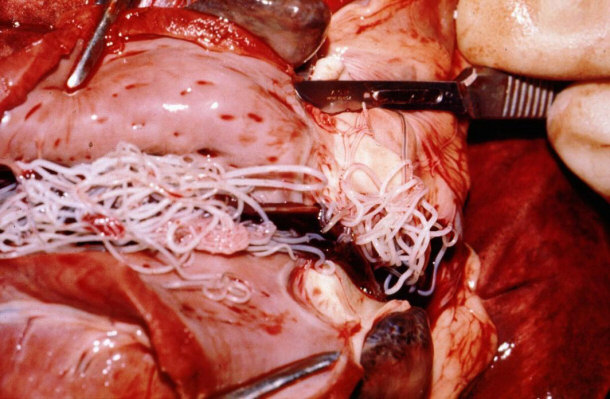
By Alan R Walker
via Wikimedia Commons
Although the parasites are referred to as heartworms, they tend to cause more
damage on the lungs because in the better part of their life they largely
inhabit the lung arteries as well as the pulmonary artery blood vessels.
Nonetheless, adult worms may move and reside on the right side of the heart of a
dog where they live in the great veins causing damage to the heart.
How do heartworms infect dogs?
Heartworms are spread through mosquito bites. When the heartworms develop to
adults, the females release offsprings known as microfilariae, which move to the
bloodstream of a dog. If a mosquito bites a dog infected with microfilaria, the
mosquito gets infected with these offsprings. The microfilariae live in a
mosquito for about 10 to 14 where they develop to infective larvae.
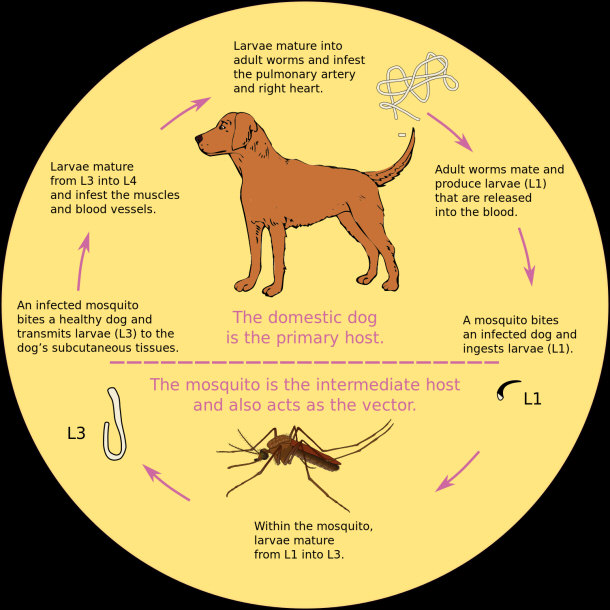
By Anka Friedrich
via Wikimedia Commons
One thing with these heartworms is that the microfilariae cannot become
infective if they do not pass through a mosquito. If the mosquito bites a
healthy dog, it infects it with the larvae through the bite wound. When
heartworm larvae have entered the bloodstream of a dog, it takes about 6 to 7
months for them to develop to adult worms.
Removed Heatworms:
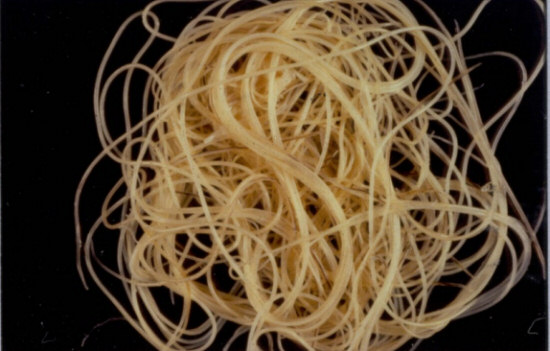
After the worms reach maturity, they begin mating and reproducing in a dog
with the females releasing their offsprings into the bloodstream. Once the
offsprings are released to the dog’s bloodstream, the lifecycle is complete and
larvae can start infection in other dogs when picked by a mosquito. Heartworm
disease is only spread through a mosquito bite and it is not a contagious
disease.
How can you detect that your dog is suffering from heartworm disease
Heartworms cause various complications when they infect a dog and the symptoms
will largely depend on the worm burden (the number of worms in a dog), the dog
size, the level of activity or activeness of the dog and the parts of the body
where there is heavy infestation. These worms cause organ failure including the
heart, lungs, liver, and kidneys as well as infection of the surrounding tissue
like the blood vessels. In their early infection, dogs may not show signs and
they can lead a pretty normal life. However, when the
infection is high or the dog is very active, the signs begin to show up.

As the
infection progresses, physiological changes are witnessed in the dog’s body. The
advancement of the infection can be categorized into different stages which
include;
-
Stage
I - This is the initial period of infection and in most cases, there may
be little signs or no noticeable signs at all. In this stage, the infection
has already begun and it is only a matter of time before the dog is
overwhelmed by the worm burden. One symptom noticed in a dog at this stage
is an occasional mild cough. If your dog has started coughing, you need to
contact a veterinarian to examine it.
- Stage II - In this stage, your dog shows mild to moderate
symptoms. The number of worms may have increased causing more harm that
begins to show signs. The coughing is still occasional and the dog appears
tired after a moderate physical activity.
- Stage III - This is where the signs show up clearly. As the worm
infection advances, the dog suffers more. The occasional coughing becomes
frequent. Your dog experiences a weight loss. It also looks unwell and may
spend much of its time resting in a corner of your home. After a mild
activity, the dog seems very fatigued. Moreover, your dog also shows
complications in breathing and the heart may begin failing. A chest x-ray
may be required to examine the damages in heart and lungs due to increased
worm burden.
- Stage IV - This is the most serious stage of heartworm disease
and is referred to as the vena cava or caval syndrome. Heavy worm burden leads to blockage of
blood vessels causing impaired flow of blood back to the heart. Dogs that have
reached this infection stage require surgical procedure to remove the worms.
However, not many dogs will survive the caval syndrome and they will eventually
die even after a surgery. Nonetheless, some dog heartworm infections may not
develop to caval syndrome.
In severe infections, a dog may show abnormal sounds of the lungs and liver
enlargement. Your dog may also show signs of fainting due to poor circulation of
blood to brain arising from blockage of blood vessels by the worms something
that leads to temporary loss of consciousness.

In addition, a dog may have
abnormal heart sounds and fluid that accumulates in the abdominal cavity. Such
symptoms can easily lead to death of your dog if not checked immediately.
Diagnosis of Heartworms in a Dog
Different tests may be performed to determine the presence of heartworms and
microfilariae larvae in the body of a dog. These tests include antigen test,
microfilarial concentration test and chest X-ray. The most accurate test is the
antigen test, which involves identifying an antigen that is produced by adult
female heartworms. However, in this test, there may be false results especially
during early infection before the worms develop to adults.
Chest X-rays May Show Signs of Heartworms in Dogs:
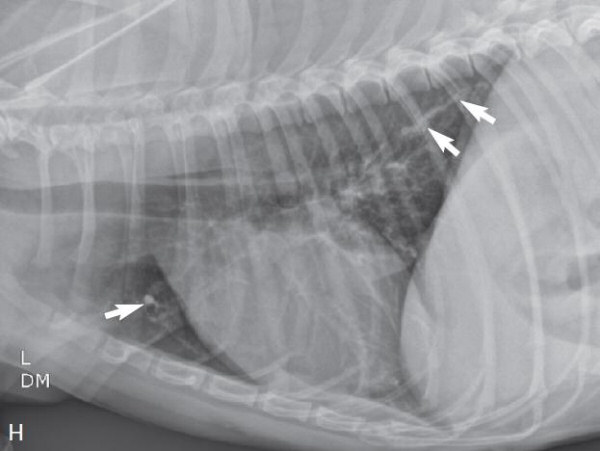
A false antigen test may also occur if there are few adult heartworms in body
and when the worms are only males. When all's said and done, false tests are a
rare occurrence. Dogs that have few worms remain asymptomatic and they may not
show symptoms until the number of worms has increased substantially to begin
causing more harm.
A veterinarian may also perform a microfilarial concentration test. In this
test, a blood sample is taken and examined under a microscope to find out if
there are microfilariae in the blood specimen. Again, a negative test result may
occur but this does not rule out presence of the infection. This is because;
about 10 to 25 percent of dogs do not have microfilariae in the peripheral
blood. This means that a dog may be infected with the worms but they have not
yet migrated to the peripheral blood.

In severely ill dogs, chest x ray is the best test to perform because it
shows the extent of damage that the worms have caused. With heavy infection or
high worm burden in pulmonary artery, the imaging may show enlargement of the
heart ventricle. Other tests may also be done such as an electrocardiogram-ECG,
which may show heart arrhythmias and enlargement of the right ventricle.
Because low worm burden may result to asymptomatic condition where no signs
are noticed in a dog, this can prevent the early detection of the infection.
This gives the worms a chance to multiply inside the dog’s body thus causing
harm. By the time the worms are detected, they have already caused serious
health complications to your dog. For an effective treatment and to save the
life of your dog, an early diagnosis of heartworm disease is needed.
What are the treatment options available for dog heartworm infection?
Treatment of heartworm disease in dogs is aimed at eliminating microfilariae
and the adult worms. The treatment of the infection depends on severity of the
symptoms and the location where there is heavy infection. Complications of drug
toxicity as well as dislodging of dead worms to the lungs should be examined
when providing treatment.
There are two drugs that have been approved by the FDA in treating heartworm
disease in dogs and they are namely; thiacetarsamide and melarsomine. Of these
two drugs, melarsomine, which is sold under the brand name immiticide, is safer
than thiacetarsamide which is marketed under the name Caparsolate.
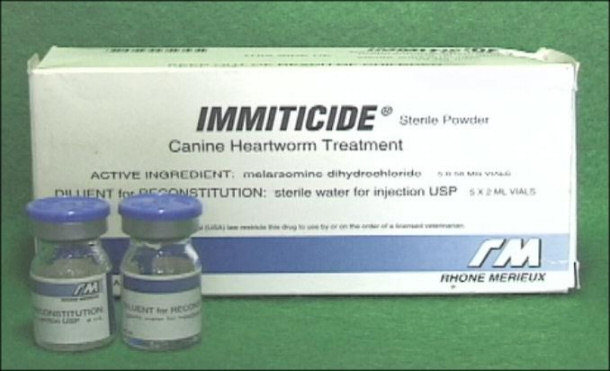
It is important that you discuss with the veterinarian on the most suitable
drug to be applied in treating your dog of heartworm infection. The
thiacetarsamide drug is injected directly into the vein (intravenously). The
drug may be administered two times a day for two days. The use of
thiacetarsamide or Caparsolate has side effects like loss of appetite, vomiting,
diarrhea, jaundice, and failure of the kidney. This drug can cause toxic
reactions and at times it can lead to death of the dog.
Another disadvantage of using thiacetarsamide drug is that it may not destroy
all the worms because the immature ones that have not developed to adults tend
to resist this medication. Before your dog is administered with Caparsolate, it
should be evaluated to ensure that it does not have high health risks like
kidney, heart, and liver complication. This is because; dogs with these
complications are not suitable for the drug.

On the other hand, Immiticide or melarsomine is more effective in treating
heartworm disease and it is capable of destroying up to 90 percent of the worms.
Another advantage with this drug is that it has fewer side effects and it may be
a good alternative for dogs that have problems of the liver, heart and kidneys.
However, it requires close supervision by a veterinarian when administering
these drugs.
Immiticide is administered through intramuscular injections. It is injected
once in a day for two days though the period of administering the drug may vary
depending on severity of the worm infection.

A surgical procedure is applied in treating dogs that are seriously ill. If
your dog has the vena cava syndrome (a serious and very severe infection of the
heartworm disease), the most appropriate treatment is a surgical procedure. A
surgery reduces the risks of kidney and liver failure in seriously ill dogs. It
also minimizes the risks of thromboembolism or dislodging of dead worms into the
veins causing blockage in blood flow.
A follow-up treatment is needed to ensure that all the worms and
microfilariae have been eliminated. When adult worms are killed with use of
drugs, a veterinarian may advise you to wait for a few weeks before your dog is
treated of larvae or microfilaria. Treatment of microfilariae may be done with
drugs like ivermectin. This is the most effective drug in destroying
microfilariae and it has fewer side effects.
To help fight heartworm disease in dogs, you need to ensure that you keep
your dog away from mosquitoes. However, this may not be easy and what you need
to do is ensure that your dog remains indoors in the evenings and afternoons to
avoid mosquito bites. Mosquitoes tend to actively feed during the evenings and
afternoons.

Another way you can control heartworm infections is by spraying your yard
with insecticides to kill mosquitoes. The mosquitoes breed in areas with
stagnant water and this means that if there are any swampy areas within your
premises, the waters should be removed. In areas that are prone to heartworm
infections, dog heartworm prevention pills may be used as prevention measures.
Last but not least, your dog may need to be tested after sometime to determine
if it has been infected with these dangerous worms.
By Chemically Treating Your Yard You Decrease the
Likelihood of Heartworms:
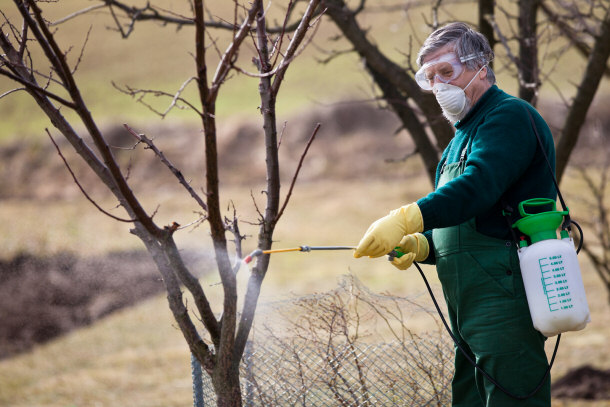
In a nutshell, the severity of heartworm disease is determined by the number
of worms in a dog. A dog may have one to 250 worms and the more the number, the
severe the symptoms. The activity of the dog also determines how severe the
heartworm disease symptoms are. In addition, the period of infection and the way
in which the dog’s body responds to the infection also determines the severity
of symptoms. The first signs you should look for in a dog are occasional
coughing, change from active state to a sedentary life, and lethargy after a
mild activity.
Pets
Top Lists:
18 Richest Animals in the World
15 Exotic Pets You Could Own Today
Top 20 Common Substances That Are Toxic to Cats and Dogs
Informational:
Animal Actors: Pets in the Film, TV, and Print Industry
Caring for a Yorkshire Terrier: Facts You Should Know
Caring for a Pig as a Pet: The Pot-bellied Pig and the Micro Pig
Difference Between a Cat Person And a Dog Person
Should You Microchip your Cat or Dog?
How to Raise and Care for Pygmy Goats
Caring for Unique Pets: The Leopard Gecko
Use Food-Grade Diatomaceous Earth to Kill Fleas Naturally
Dogs:
Top Lists:
Top 15 Dog Breeds For Home Protection
15 Fascinating Facts About The Mastiff
Informational:
How To Teach Your Dog to Hunt for Truffles
Caring for an English Bulldog: Tips and Basic Info
Cranial Cruciate Ligament (CCL) Tears in Dogs: Treating the Injury
How To Keep Your Dog free of Heartworm Disease
Dog With Separation Anxiety?
Cats:
Top Lists:
Top 6 Qualities in an Awesome Cat
Informational:
How to Control Fighting Felines
How to Get Your Cat to Exercise
Fish:
Fish 101 for the Hobbyist: The Fish’s Body and Senses
Buying a Saltwater Aquarium: What You Need to Know
Graduating to a Saltwater Tank
|